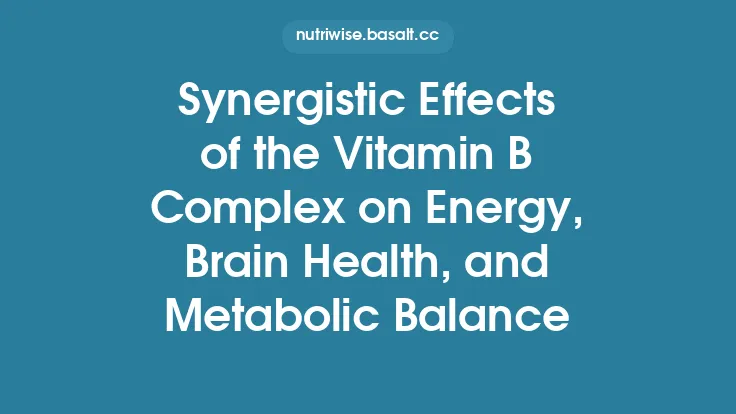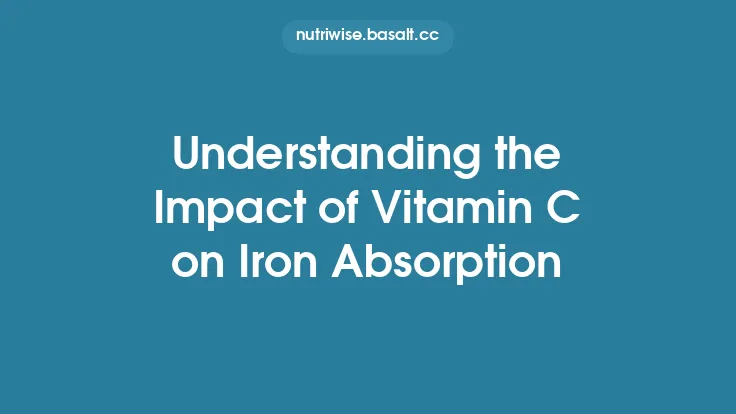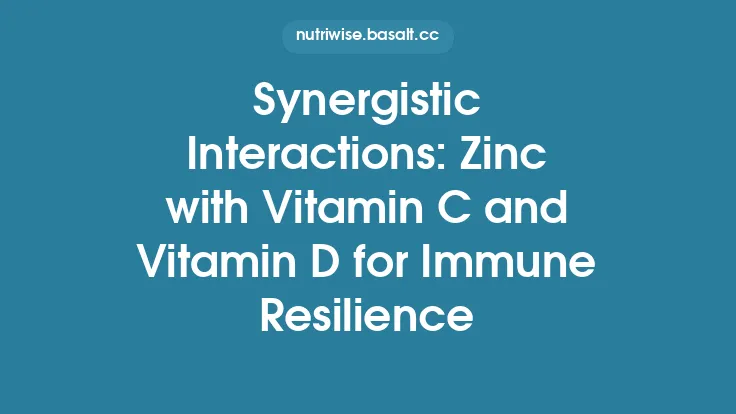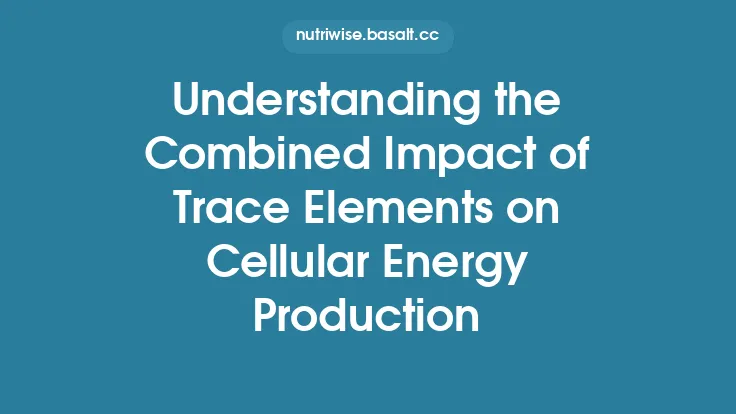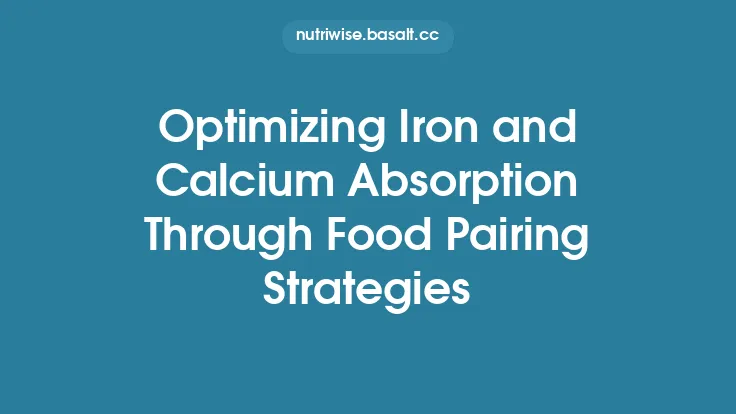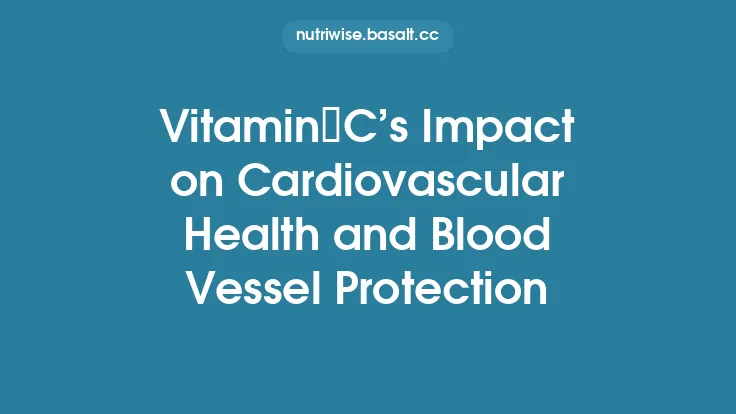Vitamin C (ascorbic acid) and iron are two of the most extensively studied micronutrients in human nutrition. Their interaction is a classic example of a synergistic relationship in which one nutrient markedly enhances the absorption and utilization of the other. This synergy is rooted in well‑characterized chemical, cellular, and physiological mechanisms that have been documented for decades and continue to inform dietary recommendations, clinical practice, and the design of fortified foods. The following article explores these mechanisms in depth, emphasizing evergreen concepts that remain relevant across diverse research contexts.
Physiological Overview of Iron Metabolism
Iron exists in two oxidation states in biological systems: ferrous (Fe²⁺) and ferric (Fe³⁺). The majority of dietary iron is present as non‑heme iron, which is predominantly ferric. Heme iron, derived from animal sources, is already in the ferrous state and is absorbed via a distinct pathway. Non‑heme iron must first be reduced to Fe²⁺ before it can be transported across the apical membrane of enterocytes.
Key steps in systemic iron handling include:
- Luminal Reduction – Conversion of Fe³⁺ to Fe²⁺ at the brush‑border surface.
- Apical Uptake – Transport of Fe²⁺ into enterocytes primarily via the divalent metal transporter‑1 (DMT1).
- Intracellular Trafficking – Binding to cytosolic chaperones (e.g., poly(rC)-binding protein 1) and storage in ferritin.
- Basolateral Export – Ferroportin (FPN) mediates iron efflux into the portal circulation, where it is oxidized back to Fe³⁺ by hephaestin or ceruloplasmin and bound to transferrin.
Regulation occurs at multiple levels: transcriptional control of DMT1 and ferroportin, post‑translational modulation by hepcidin (the master iron‑regulatory hormone), and feedback from cellular iron pools. Understanding how vitamin C influences the initial reduction step is essential to grasp the overall synergistic effect.
Vitamin C Chemistry and Redox Properties
Vitamin C is a water‑soluble antioxidant that exists primarily as the reduced form, ascorbic acid, and its oxidized counterpart, dehydroascorbic acid (DHA). The redox couple:
\[
\text{Ascorbate} \; \rightleftharpoons \; \text{Dehydroascorbic Acid} + 2e^- + 2H^+
\]
confers a standard reduction potential of +0.06 V at physiological pH, making ascorbate a potent electron donor. This property enables vitamin C to:
- Directly reduce Fe³⁺ to Fe²⁺ in the intestinal lumen.
- Regenerate other antioxidants (e.g., vitamin E) and maintain the reduced state of iron‑containing enzymes.
Because the reduction of Fe³⁺ is a non‑enzymatic, diffusion‑limited reaction, the concentration of ascorbate in the gut lumen strongly influences the rate at which ferric iron becomes bioavailable for transport.
Molecular Mechanisms of Vitamin C–Mediated Iron Reduction
- Direct Chemical Reduction
In the acidic environment of the proximal duodenum (pH ≈ 5.5–6.0), ascorbate donates electrons to ferric complexes (Fe³⁺‑ligand). The reaction proceeds rapidly:
\[
\text{Fe}^{3+}\text{-L} + \text{AscH}^- \rightarrow \text{Fe}^{2+} + \text{L} + \text{Asc}^\bullet
\]
where L denotes a dietary ligand (e.g., citrate, phytate). The resulting Fe²⁺ is now a suitable substrate for DMT1.
- Chelation‑Facilitated Reduction
Ascorbate can form transient complexes with Fe³⁺, stabilizing the metal in solution and preventing precipitation as insoluble hydroxides. This chelation effect increases the local concentration of reducible iron.
- Prevention of Oxidative Re‑oxidation
By maintaining a reducing environment, vitamin C limits the re‑oxidation of Fe²⁺ back to Fe³⁺ before transport. This is particularly important in the presence of oxygen and other oxidants in the lumen.
- Interaction with Mucosal Enzymes
While the primary reduction is non‑enzymatic, ascorbate may also support the activity of brush‑border ferric reductases (e.g., duodenal cytochrome b, Dcytb) by providing a favorable redox milieu, thereby enhancing enzymatic turnover.
Transporters Involved in Iron Uptake: DMT1 and Others
Divalent Metal Transporter‑1 (DMT1) is the principal conduit for ferrous iron across the apical membrane of enterocytes. Its key characteristics include:
- Broad Substrate Specificity – Transports Fe²⁺, Mn²⁺, Co²⁺, and other divalent cations.
- pH‑Dependent Kinetics – Optimal activity at acidic pH, aligning with the duodenal environment.
- Regulation by Iron Status – Up‑regulated during iron deficiency via hypoxia‑inducible factor‑2α (HIF‑2α) and down‑regulated when iron stores are replete.
Vitamin C does not directly modulate DMT1 expression, but by increasing the pool of Fe²⁺, it indirectly raises the substrate availability for DMT1, thereby enhancing net iron flux.
Other transporters that may be influenced indirectly include:
- ZIP14 (SLC39A14) – Facilitates uptake of non‑heme iron under inflammatory conditions.
- TRPML1 (Transient Receptor Potential Mucolipin‑1) – Involved in endosomal iron release; vitamin C can affect endosomal pH, potentially modulating this pathway.
Cellular Iron Homeostasis and Regulation by Ferritin and Ferroportin
Once inside the enterocyte, iron is either stored in ferritin or exported via ferroportin. Vitamin C continues to play a role beyond the lumen:
- Ferritin Iron Release – Ascorbate can reduce ferric iron stored in ferritin, promoting its mobilization for export. This intracellular reduction is essential during periods of increased demand (e.g., erythropoiesis).
- Ferroportin Activity – The export step requires oxidation of Fe²⁺ back to Fe³⁺, a reaction catalyzed by hephaestin. Adequate ascorbate levels ensure a balanced redox cycle, preventing accumulation of excess Fe²⁺ that could generate reactive oxygen species (ROS).
Hepcidin, the hepatic peptide hormone, binds ferroportin and triggers its internalization and degradation. While vitamin C does not directly affect hepcidin synthesis, improved iron absorption can lead to downstream hepcidin up‑regulation, establishing a feedback loop that maintains systemic iron balance.
Impact of Vitamin C on Non‑Heme Iron Bioavailability
Numerous controlled feeding studies have demonstrated that co‑consumption of vitamin C with non‑heme iron sources (e.g., legumes, fortified cereals) can increase fractional iron absorption by 2–3 fold. The magnitude of the effect depends on:
| Variable | Low Vitamin C (≤25 mg) | Moderate Vitamin C (≈50 mg) | High Vitamin C (≥100 mg) |
|---|---|---|---|
| Relative increase in Fe absorption | 1.2–1.5× | 2–2.5× | 3–4× |
| Influence of inhibitors (phytate, polyphenols) | Minimal | Moderate mitigation | Strong mitigation |
These data underscore the practical relevance of the biochemical mechanisms described earlier. Even in meals rich in iron absorption inhibitors, sufficient vitamin C can overcome the negative impact by maintaining iron in the ferrous, transport‑ready form.
Synergistic Effects in Different Cellular Contexts
Enterocytes
The primary site of dietary iron uptake. Vitamin C’s luminal reduction of Fe³⁺ directly translates into higher intracellular iron pools, influencing both storage (ferritin) and export (ferroportin).
Macrophages
Macrophages recycle senescent erythrocyte iron. Ascorbate within the phagolysosome reduces ferric iron released from heme, facilitating its transfer to the cytosol and subsequent export. This process is crucial for maintaining plasma iron levels during steady‑state erythropoiesis.
Erythroid Precursors
Developing red blood cells require large amounts of iron for hemoglobin synthesis. Vitamin C can enhance iron availability in the bone‑marrow microenvironment by supporting the reduction of extracellular iron and by modulating the redox state of iron‑containing enzymes (e.g., prolyl hydroxylases involved in erythropoietin signaling).
Dietary Considerations and Practical Implications
- Meal Pairing
*Combine vitamin C‑rich foods (citrus fruits, strawberries, bell peppers, kiwi) with iron‑dense plant foods (spinach, lentils, beans) to maximize absorption.*
- Timing
*Consuming vitamin C within 30 minutes of the iron source yields the greatest synergistic effect, as the reducing environment is most potent before gastric emptying dilutes the ascorbate concentration.*
- Supplement Formulation
*Iron supplements often include ascorbic acid or its derivatives (e.g., sodium ascorbate) to improve bioavailability. Controlled‑release formulations that co‑deliver both nutrients can mimic the natural synergistic interaction.*
- Population‑Specific Guidance
*Pregnant women, adolescents, and individuals with iron‑deficiency anemia benefit most from vitamin C co‑intake, given their heightened iron requirements.*
- Potential Interactions
*While vitamin C enhances iron absorption, excessive supplementation (>1 g/day) may increase oxidative stress in susceptible individuals. Balanced intake aligned with dietary reference intakes (DRIs) is advisable.*
Potential Clinical Applications and Future Research Directions
- Therapeutic Iron Repletion – Oral iron therapy combined with vitamin C has shown improved hematologic outcomes compared with iron alone, especially in patients with mild to moderate deficiency.
- Anemia of Chronic Disease – Modulating the redox environment with ascorbate may help overcome hepcidin‑mediated iron sequestration, though clinical trials are needed.
- Nanoparticle Delivery Systems – Emerging research explores ascorbate‑coated iron oxide nanoparticles that exploit the reduction mechanism for targeted cellular uptake.
- Genetic Variants of DMT1 – Investigating how polymorphisms affect the magnitude of vitamin C‑mediated enhancement could personalize nutrition recommendations.
- Gut Microbiome Interplay – Although outside the scope of this article, preliminary data suggest that ascorbate influences microbial iron metabolism, a promising avenue for future investigation.
Concluding Remarks
The synergistic relationship between vitamin C and iron epitomizes how micronutrients can interact at the chemical, cellular, and systemic levels to shape nutritional status. Vitamin C’s ability to reduce ferric to ferrous iron, prevent re‑oxidation, and support intracellular iron trafficking creates a cascade of effects that culminate in markedly improved iron absorption and utilization. These mechanisms are robust, well‑documented, and remain highly relevant for dietary planning, clinical nutrition, and the development of fortified products. By integrating vitamin C strategically into meals and supplementation regimens, practitioners can harness this synergy to address iron deficiency—a pervasive public health challenge—while maintaining a balanced redox environment essential for overall health.
